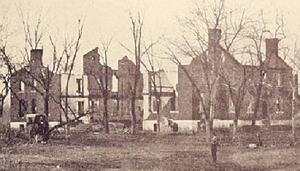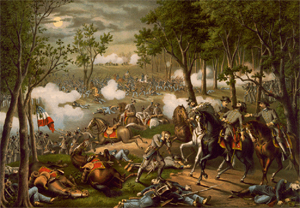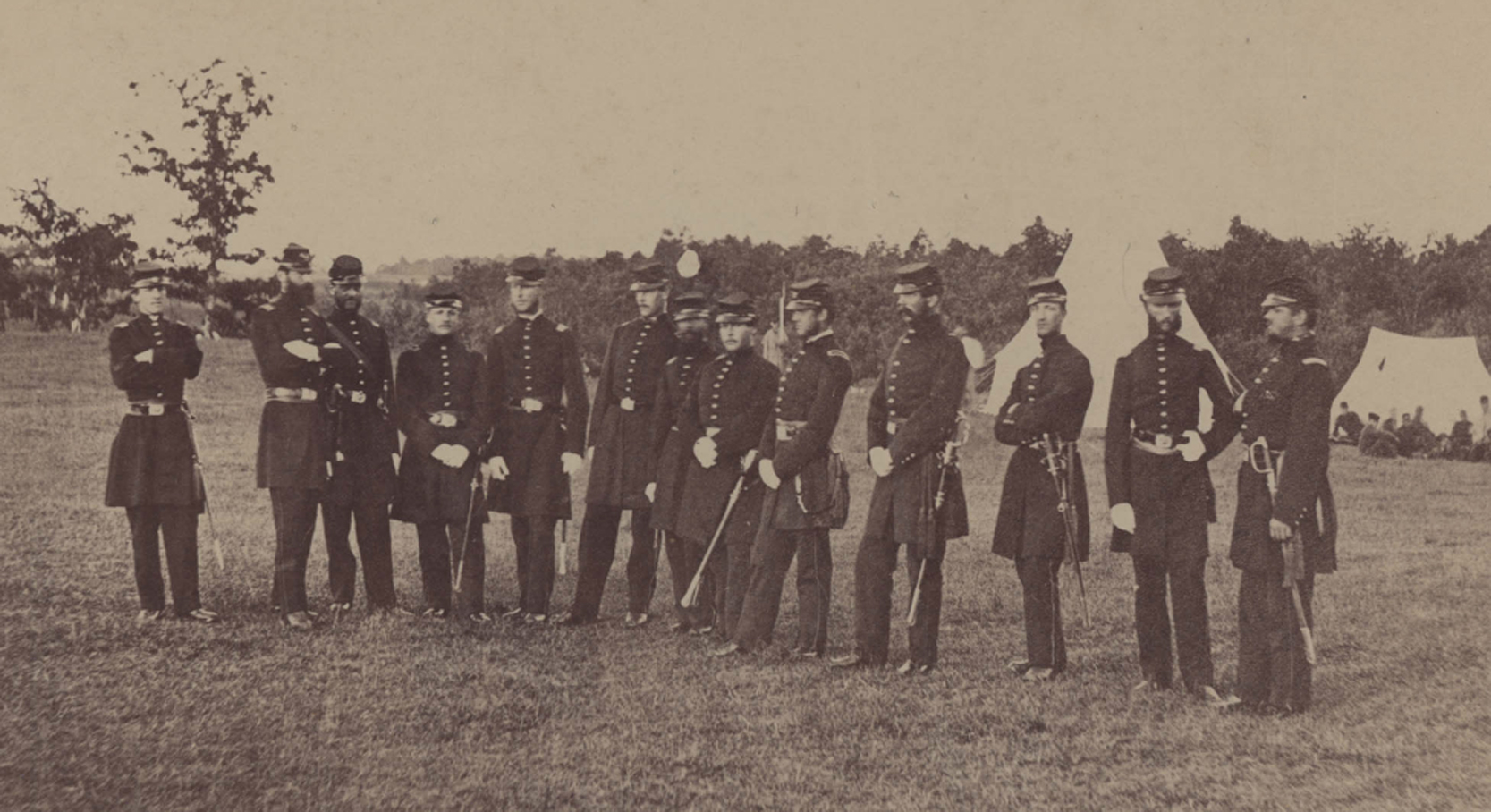Prelude: The Battle of Fredericksburg (Maryland)
December 11-15, 1862
Great battles in the Civil War can rarely be taken out of context. In other words, it is important to understand a little of the chronology of previous battles to fully understand the purpose and consequences of those that followed. While a full recap of the Battle of Fredericksburg, Maryland from December 11-15, 1862 is not necessary here (especially since the 2nd Mass was not involved in that conflict), it is important to understand in the larger scheme of Union strategy preceding Chancellorsville.
At Fredericksburg, wave after wave of Union soldiers perished trying unsuccessfully to dislodge the enemy in a superior position along Marye’s Heights.1 The severe Union losses there (over 12,000 killed, wounded or captured compared versus just under 6,000 Confederate losses) had a morale-boosting effect on Southern forces and the exact opposite effect on Northern troops.2 Fredericksburg was a major win for General Robert E. Lee, one which would embolden him to take risky chances in the future.

The Battle of Chancellorsville (Maryland)
April 27 – May 6, 1863
Throughout the Civil War, President Abraham Lincoln had had a difficult time finding and keeping generals who would follow his orders. He was constantly searching for aggressive and persistent leaders who would press an advantage against the Confederate foe. Instead, he promoted a series of men who "looked good on paper" but failed when given the responsibility of supreme command.
This unfortunate circumstance was exacerbated by the appointment of Major General Joseph “Fighting Joe” Hooker in January of 1863 to replace Major General Ambrose Burnside in commanding the Army of the Potomac.3 Ironically, in the three months leading up to the Battle of Chancellorsville, Hooker did much to increase the morale of 134,000 troops: the men were well-fed, equipment and uniforms were replaced.4 And most importantly, he had developed a plan as to how to attack the significantly smaller 60,000 men of the Confederate Army of Northern Virginia entrenched at Fredericksburg, Maryland.
He meant to draw out Lee from his position at that city by sending a large cavalry force west across the Rappahannock River from a point below the city to cut off his line of supplies coming up from the South.5 That done, Lee would be unable to hold his position at Fredericksburg, which had been by then under a state of near siege for many weeks. As Lee retreated from the city, either south or west, Hooker meant to swoop down from the North with the main body of his force and attack Lee.6
Between April 27 and April 29, Hooker’s plan began by moving about 40,000 men, undetected, west across the Rappahannock River at Kelly’s Ford, Virginia, far north of Fredericksburg and the left flank of Lee’s army.7 They then proceeded south to cross the Rapidan River at Germana Ford. Their ultimate destination was Chancellorsville. On April 29, Hooker directed an additional two corps of 40,000 men to cross the Rappahannock River south of Fredericksburg, drawing Lee’s attention to his right flank.8 (Only about 17,000 made the actual crossing, with the additional men remaining on the east side of the river.) That same day, Hooker’s maneuvering in the north was discovered and reported to Lee. Lee now knew that he had two sizeable forces of the enemy both to the north and to the south. He called to the Confederate capital at Richmond to send more troops.9 By the end of the next day, there would be nearly 100,000 union soldiers at, or en route, to Chancellorsville from the north and east. Hooker ordered his generals to hold position there and wait.10
Lee was faced with two main choices: move solidly against Hooker's superior force at Chancellorsville or retreat south towards Richmond. Hooker was counting on Lee's previous success at Fredericksburg just a few months before to embolden him to strike at him. But Hooker was both right and wrong in that assessment: Lee would indeed move against him…but in a completely unexpected manner.

Chancellorsville
At the time of the great battle, Chancellorsville, Virginia was not a town; it was not even a village. Essentially, it was just an a two-storey brick house, run as an inn by George Chancellor at the axis of the Orange Plank road (which ran west-to-southeast), the Orange Turnpike (which ran east-to-west), Ely’s Ford Road (which descended from the northwest) and River Road (which ascended to the northeast). The “hamlet” was located about 13 miles due west from Fredericksburg.11
Virtually surrounding Chancellorsville on its north, west and south sides was an area known as “the Wilderness,” a dense thicket of overgrown trees, bushes and scrub brush. It was in this area that Hooker assembled his army, adopting a defensive strategy, hoping to pull Lee into attacking his mostly-hidden forces.13

Lee makes his move
There is an old military tenet that advises “Never divide your force in the presence of a superior enemy.” Lee did just that, not once but twice. First, he divided his army, leaving about 11,000 men at Fredericksburg to keep the Union’s 40,000 men engaged there.14 Then he moved rapidly west, arriving near Chancellorsville on May 1. Confederate General Stonewall Jackson’s troops met Union forces just before 11 a.m. Despite heavy combat that first day, Hooker was not able to get his army where he wanted them. So by nightfall, he ordered his men back, again hoping to pull Lee into a full frontal assault from the relative safety of the Wilderness around Chancellorsville.15
It was at this point that General Lee divided his army once again. Discovering that the right flank of the Union line was “in the air” (meaning that it was not protected by any hilly geographical terrain or by manmade fortifications, known as “breastworks”), Lee and Jackson decided to attack on two fronts. Jackson would lead his full 29,000 men to the southwest and then north through the Wilderness using old logging roads in order to come up behind Union forces from the west. Meanwhile, Lee would draw a frontal attack from the east along the Orange turnpike and Orange Plank Roads using the remaining force of 14,000 Confederates…against 70,000 Union soldiers! And so it began, the morning of May 2.16
The move was unbelievably audacious. Such a long column of men proceeding through the underbrush could have been spotted. And in fact, they were, a number of times.18 But no significant action was taken against them. By the time that the Confederate troops broke out of the woods to attack the Union 11th Corps under Major General Oliver Howard around 5:30 p.m., there was no suspicion of any impending danger.19
The entire corps was routed and forced back towards Chancellorsville to the east.20 The only thing that prevented even more casualties (2,500 in the 11th Corps alone) from this surprise attack was nightfall.21
[Important historical side note: this night, hoping to press his advantage, General Jackson took a small party of men out to reconnoiter. Returning, the group was misidentified by their own men and they were fired upon. Jackson caught three bullets, one breaking his arm, which subsequently had to be amputated.22 Jackson died of pneumonia 8 days later. His loss was devastating to Lee’s command.]
May 3rd turned out to be the second bloodiest day of the entire Civil War up to that point (Antietam being the first). And over the course of next several days, Lee kept up his attacks on Union forces, eventually forcing them to retreat back across the Rappahannock River by May 6.23 To the south, forces at Fredericksburg had been successful (at high cost of life) in pushing through the Confederate line but could not press on west to Chancellorsville. They too retreated back across the river on May 7, ending the campaign.
The losses were considerable on both sides: of 134,000 Union soldiers, there were over 17,000 casualties. Of 60,000 Confederate troops, just over 13,000 were casualties.24 As it was much more difficult for the South to replace these men, Lee’s losses were more significant.
Even so, this battle is considered one of General Lee’s greatest successes and further fueled his view that his army could not be stopped. He believed he could ask anything of his men and they would accomplish it.25 Not so for General Joe Hooker. Although President Lincoln did not initially relieve Hooker of his command immediately following the battle, Lincoln realized that Hooker was another failure. He finally replaced him on June 28, 1863 with Major General George Meade, just prior to the great Battle of Gettysburg.26

The 2nd Massachusetts Infantry at Chancellorsville
[A quick note here: as mentioned previously concerning the number of soldiers that constituted a regiment, by the time of this battle, regiments were no longer likely to have 1000 men. It was by then more likely that they would have less than 600. In fact, at Gettysburg, just a few months in the future, the average regiment was less than 400 men.]
The 2nd Mass crossed the Rappahannock River on April 29th and arrived at Chancellorsville on the 30th. As a regiment of the 12th Corps assigned to General Henry Slocum, they were placed along the eastern front of the Union line. Hooker used the morning of May 1st ('a fine, clear day') to consolidate his position around the Chancellorsville house. So it was not until the afternoon that the regiment moved forward to engage the enemy. Following a skirmish of just a couple of hours, an order was received to return to their original position of the morning. The order was not well received as the troops wished to press their advantage but the order was followed. Overnight, the Corps built breastworks to support their location on Fairview Hill, just southwest of the main house.27
On the morning of May 2nd, reports of Confederate troops moving through the heavy brush and woods to the southwest were interpreted as a possible retreat of Lee’s army. Eventually, Slocum’s Corps were ordered to intercept the retreating soldiers and try to capture as many as possible. Working through the heavy brush proved difficult for the soldiers and they had little to no success.28

Marye's Heights at Fredericksburg during the
Chancellorsville Campaign29
When Jackson’s men suddenly broke through the woods to the rear around 5:30 p.m., attacking the 11th Corps and causing them to flee, it was the 2nd Mass, the 27th Indiana and the 3rd Wisconsin who helped to hold the line against the Confederates.29
Over the next few hours, the 2nd Mass and its fellow regiments (3rd Wisconsin and 27th Indiana) were able to dislodge the enemy and regain their former position on Fairview Hill. Heavy artillery and rifle fire continued throughout the night as they worked to reinforce their breastworks. There was no sleep to be had.30
By dawn of May 3rd, the Confederates made continual, aggressive attempts to push through the Union line between Hazel Grove and Fairview Hill. Three times, the three Union regiments forced back the enemy. At one point, the regiments faced the 1st South Carolina and, although just 75 yards or so apart, both sides stood, firing nonstop at each other, for at least 30 minutes.32 By 7 a.m., nearly every 2nd Mass infantryman had exhausted the 60 rounds of ammunition he had been allotted. Unable to secure more from command, the regimental officers passed around rounds assembled from those dead and wounded on the field.33
With only a few rounds of ammunition left, Colonel Sam Quincy gave the order to his exhausted men to “fix bayonets” in preparation for hand-to-hand combat. It was only at that point that the 13th New Jersey was finally called in to relieve them.34 Falling to the rear of the front lines, the 2nd Mass was removed from the fighting for the rest of the day. Eventually, the rebels took control of both Hazel Grove and Fairview Hill after General Hooker ordered them abandoned. Their bravery had been for naught.
The night of May 3rd was spent supporting other Corps and forming lines of skirmish against the enemy. Although they could be seen, the Confederates did not press forward.35 Colonel Sam Quincy had this to say about the fighting the 2nd Mass endured on this day:
"Once more have I by the grace of God come out safely from about as much hell as a man often experiences in this world. I think I could write a fine description of Pandemonium if I tried for if that Kingdom of Satan wouldn't pale its ineffectual fires before the battles of Saturday midnight & Sunday morning at Chancellorsville, then the Devil is a bigger man than I take him to be." 36
Dawn of May 4th brought renewed artillery fire which was quickly answered by Union batteries before it ceased after about an hour. The regiments reinforced their breastworks throughout the day and there were no more attacks.37
May 5th was much the same as the previous day and in the late afternoon of May 6th, the Corps was finally ordered to fall back to the Rappahannock and cross back over. The Battle of Chancellorsville was finally over for the men of the 2nd Massachusetts.38

Richard Goodhind
As mentioned before, we have no firsthand accounts from Richard Goodhind as to his personal actions during the Battle of Chancellorsville. We do know that he was wounded during this battle, having been shot in the left leg (according to an application for a miltary pension he made many years later). The severity of the wound is unknown but he did not leave his regiment and that is a significant thing. Many of these bullet wounds led to infection. If the infection was severe, amputation and death could follow. But this was not the case for Richard. A total of 24 members of his regiment were killed in this battle and another 91, including Richard, were wounded.
It would be gratifying to know whether he had been wounded in the face-to-face rifle fire on Fairview Hill on May 3rd. Or perhaps he was wounded by some stray bullet earlier during the conflict. We have no way of knowing now, so many years after the fact. But we do know that Richard was still with his regiment two months later at perhaps the most famous and pivotal battle of the entire war: Gettysburg.
_______________________
1 Sears, Chancellorsville, 2-3.
2 Sears, 2-3, 11-12.
3 Sears, 19-25.
4 Sears, 73-74, 80-81.
5 Sears, 118-119.
6 Sears, 131.
7 Sears, 141-153.
8 Sears, 153-159.
9 Sears, 160.
10 Sears, 181.
11 Sears, 97-100.
12 "Ruins of Chancellorsville house in 1865," Library of Congress, LOT 4167, no. 11 [P&P]. No known restrictions on publication.
13 Sears, 193.
14 Sears, 188-189.
15 Sears, 211-213, 231.
16 Sears, 234-235.
17 Battle of Chancellorsville, published by Kurz & Allison, Chicago, IL, 1889.
18 Sears, 244-245, 264-266.
19 Sears, 272-274.
10 Sears, 275-278.
21 Sears, 290.
22 Sears, 293-297.
23 Sears, 364-365.
24 Sears, 428-430.
25 Sears, 366
26 Sears, 445, 449.
27 Kennedy,“1 May.”
28 Kennedy, “2 May,” paragraphs 3-5.
29 http://en.wikipedia.org/wiki/Battle_of_Chancellorsville#mediaviewer/File:Trenches_ petersburg.jpg. No known restrictions to publication.
30 Kennedy, “2 May,” paragraph 8.
31 Kennedy, “2 May,” last paragraph.
32 Sears, Chancellorsville, 319.
33 Kennedy, “3 May,” paragraph 8-9.
34 Kennedy, “3 May,” paragraph 10.
35 Kennedy, “3 May,” paragraph 15.
36 Kennedy, “3 May,” last paragraph.
37 Kennedy, “4 May.”
38 Kennedy, “5-6 May.”
Bibliography
1) Sears, Stephen W., Chancellorsville. New York: Houghton Mifflin Co., 1996.
2) http://www.oocities.org/pentagon/2126/index.html, “Gordon’s Regulars: The 2nd Massachusetts Infantry in the Civil War,” 1999, Lynne M. Kennedy.
______________________
Richard Goodhind in the Civil War
How the Union Army was organized
About the 2nd Massachusetts Volunteer Infantry
Chronology of service for the 2nd Mass Infantry
Listing of Enlisted Men in 2nd Mass (last name starting with a "G")
Richard Goodhind - Prisoner of War
Battle of Gettysburg
2nd Massachusetts Infantry at Gettysburg
Gettysburg Photo Gallery
Richard Goodhind's Pension File
More about the 2nd Mass Infantry (off site)














